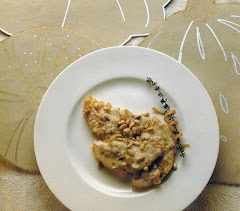
green beans, yellow wax beans

first sunflower of the season

zinnias in the garden

Thais and Will Perkins: A Louisiana gardening adventure.


 This is the result of one box from one hive. I have a feeling there will be quite a bit of honey in our near future...and I certainly hope we can figure out some other place to do this...Like - maybe outside...The scary-looking knife is HOT. (It is electric and smokes like the devil. I am in charge of the extension cords. Plug it in...when it smells like burned honey, unplug!
This is the result of one box from one hive. I have a feeling there will be quite a bit of honey in our near future...and I certainly hope we can figure out some other place to do this...Like - maybe outside...The scary-looking knife is HOT. (It is electric and smokes like the devil. I am in charge of the extension cords. Plug it in...when it smells like burned honey, unplug! Wait. Plug it in. etc. etc.) The goal is to uncap the little cells the bees have made...stick the racks in the big aluminum thing and spin!
Wait. Plug it in. etc. etc.) The goal is to uncap the little cells the bees have made...stick the racks in the big aluminum thing and spin! A very sticky business, all in all. I have to hand it to Will, though.
A very sticky business, all in all. I have to hand it to Will, though.  When he decides to get something done (like, bees...like, honey) he gets it done completely, and in very short order! In the end, my thought is this: I have never really seen this much honey in one container in one place - ever.
When he decides to get something done (like, bees...like, honey) he gets it done completely, and in very short order! In the end, my thought is this: I have never really seen this much honey in one container in one place - ever. 
 Not a hard decision - we'd been thinking about this for a while anyway. But the distinct and mildly frightening lack of bees on this property all spring sealed the deal. Where to get a hive? I found the Louisiana Beekeepers on the 'net. Emailed the current president. He got right back to me. Actually, what he really wanted was for Will to show up at the Tuesday meeting. I kept pushing him for a contact instead - which he did give. But Will thought - no - best to go to the meeting. That was smart. Lots of bee folks, actually; and very nice folks indeed. He came away with cards and phone numbers and whatnot. And a direct line to a guy across the river who had ten or so hives he was trying to sell. So - the following Saturday evening Will goes across the river to Morganza and buys two hives (full of bees, naturally), and a big metallic thing that spins out the honey (looks like a giant ice-cream maker). He calls from the other side of the river at St. Francisville. (the Mississippi river). This means he is waiting for the ferry. Now, I don't know about you, but if I was getting onto a ferry and a guy drives his pickup truck onto the ferry with two beehives full of bees in the back of the truck, I would not be well for that. It was dark, and it was Saturday night, and no one seemed to notice. ha.
Not a hard decision - we'd been thinking about this for a while anyway. But the distinct and mildly frightening lack of bees on this property all spring sealed the deal. Where to get a hive? I found the Louisiana Beekeepers on the 'net. Emailed the current president. He got right back to me. Actually, what he really wanted was for Will to show up at the Tuesday meeting. I kept pushing him for a contact instead - which he did give. But Will thought - no - best to go to the meeting. That was smart. Lots of bee folks, actually; and very nice folks indeed. He came away with cards and phone numbers and whatnot. And a direct line to a guy across the river who had ten or so hives he was trying to sell. So - the following Saturday evening Will goes across the river to Morganza and buys two hives (full of bees, naturally), and a big metallic thing that spins out the honey (looks like a giant ice-cream maker). He calls from the other side of the river at St. Francisville. (the Mississippi river). This means he is waiting for the ferry. Now, I don't know about you, but if I was getting onto a ferry and a guy drives his pickup truck onto the ferry with two beehives full of bees in the back of the truck, I would not be well for that. It was dark, and it was Saturday night, and no one seemed to notice. ha.
 There is also a clump of them way over in between two other rows. This means they seed themselves pretty freely. Lesson: if you can nurse something through the first year, you have a fighting chance. Lesson 2: Ox-Eyed. Daisies, obviously a predecessor of the Shasta Daisy, makes THING TWO in the herb beds that works because it is the hardy older variety. Thing One was the Bergamot, predecessor of the hybrid Bee Balm. (see last year). We've had Bee Balm: temperamental, and hard to pull through to next year. But Bergamot - well, it's all over the place now.
There is also a clump of them way over in between two other rows. This means they seed themselves pretty freely. Lesson: if you can nurse something through the first year, you have a fighting chance. Lesson 2: Ox-Eyed. Daisies, obviously a predecessor of the Shasta Daisy, makes THING TWO in the herb beds that works because it is the hardy older variety. Thing One was the Bergamot, predecessor of the hybrid Bee Balm. (see last year). We've had Bee Balm: temperamental, and hard to pull through to next year. But Bergamot - well, it's all over the place now.

 And a picture of this and that (thanks to Will and his new camera...he couldn't help himself but maybe I'm possessive about mine...) First - the purple martin house.
And a picture of this and that (thanks to Will and his new camera...he couldn't help himself but maybe I'm possessive about mine...) First - the purple martin house.  Will always DID want one. We do not know why we have only three pairs of martins in this, the second year. Will seems to think we would have a billion pairs...or at least one in every little apartment. I mean, he went through a lot of trouble making sure each little apartment was separated from the others (I did joke last year that he should just go ahead and give every apartment a little barbecue pit and maybe wind chimes). But we are grateful for the ones we do have, and as long as we keep our distance with the mower and the tiller, they don't fuss to much. And, of course, we have the 'pond and fountain' feature...I laughed at first (it seemed so absurd) but i have come to love it, especially the sound of water...
Will always DID want one. We do not know why we have only three pairs of martins in this, the second year. Will seems to think we would have a billion pairs...or at least one in every little apartment. I mean, he went through a lot of trouble making sure each little apartment was separated from the others (I did joke last year that he should just go ahead and give every apartment a little barbecue pit and maybe wind chimes). But we are grateful for the ones we do have, and as long as we keep our distance with the mower and the tiller, they don't fuss to much. And, of course, we have the 'pond and fountain' feature...I laughed at first (it seemed so absurd) but i have come to love it, especially the sound of water...


It’s the oxygenation, stup... Let me rephrase. In a closed ecological system with dynamic nutrient inputs, oxygen quickly becomes a limiting factor in the overall health and balance of the system. This is especially true when what you are trying to culture is dependent on oxygen to live (and thrive). Maybe the lights were unnecessary. But if you are going through all the trouble to (hand) dig 160 feet of ditch for buried cable and assemble, wire, float and anchor an aerating fountain, might as well go for broke (literally). It wasn’t THAT expensive. However, counting the price of the pond, fish, fountain, and feed we would probably much better off buying catfish at the local seafood house. Of course, we wouldn’t know where they came from and they would not be as fresh and I couldn’t witness the joy of my spouse as she catches one after the other, which I happily take off the hook and drop into the bucket (and later into the fry basket).
I’ve learned a lot about fish farming. Maybe I take it too seriously (lights excluded), but once I have committed to raising something, I start to worry about whether I have considered all the aspects and am doing what is necessary to ensure success. I hate to fail, though I have on many occasions. But I am in particularly adverse to the stinky evidence of fish farming gone bad. I blame it partly on the fish hatchery guy. I really only wanted a reasonable amount of fish for our half-acre pond, 400 hybrid bream and 150 channel catfish. In cavalier fashion, the fish guy ensured me that 1000 fish can easily be raised in a half acre pond and, besides, fish by the thousand would be much cheaper per fish than buying less. I should have known from the outset that this guy was fast and loose. After I carefully filled clean ice chests with water adjusted to pond temperature, bringing a thermometer with me to ensure no shock to the fry from the hatchery truck tanks, the guy just sticks his hand in the ice chests and says, “That’s close enough!” So now I have 1000 dependents that I can’t declare on my taxes. No way am I going to let them down, nothing too good for them. And all was well until Spring when they started to eat more and grow more and excrete more and now I am watching the pond go through textbook water quality changes. From turbid (adjusted with lime), to clear and pretty, to cloudy again (nitrophilous bacteria converting ammonia to nitrate) to matted floating filamentous algae – yuk, to now a healthy dark green (suspended algae) thanks to the fountain, the physical raking of the filamentous algae, the dry peroxide, and the application of pond microbes (the aqua-sphere Thais referred to). I’m not imagining that I am out-of-the-water on this so to speak, but I am happy with the results and you can indeed raise 1000 fish in a half-acre pond, but it takes a much greater degree of attention than it might otherwise. For those who have farm ponds or are considering them, the best publications I have found that can be accessed on-line are from the Southern Region Aquaculture Center of the USDA Cooperative State Research, Education, and Extension Service at http://srac.tamu.edu/index.cfm?catid=25

 And, for our other evening fun, I give you the latest in Will's 'POND MANIA'.....wait for it...
And, for our other evening fun, I give you the latest in Will's 'POND MANIA'.....wait for it...



 well - enough of tiny little bunches of new leaves....I mentioned the 'I Hate The Winter Grass' springtime problem, and digging out from it in the garden. It's kind of beautiful, really, because it is a deep dark green when everything else is brown and seemingly dead...but it is a terror just the same. To make my point, here is some probably wonderful fennel - but you can hardly tell, because the winter grass has taken over completely:
well - enough of tiny little bunches of new leaves....I mentioned the 'I Hate The Winter Grass' springtime problem, and digging out from it in the garden. It's kind of beautiful, really, because it is a deep dark green when everything else is brown and seemingly dead...but it is a terror just the same. To make my point, here is some probably wonderful fennel - but you can hardly tell, because the winter grass has taken over completely: and, after nearly two days of hoeing and hand-weeding, here is some of the lettuce that had suffered the same fate, but when you look the lettuce in Whole Foods, and then pull your hand back, thinking "wait. we have lettuce. I'm just lazy"....and now we have lettuce.
and, after nearly two days of hoeing and hand-weeding, here is some of the lettuce that had suffered the same fate, but when you look the lettuce in Whole Foods, and then pull your hand back, thinking "wait. we have lettuce. I'm just lazy"....and now we have lettuce.  And , after trying to crank up the mower, and going out for a new battery of course, and it could be worse, so that's good...a little part of the yard is mowed, and one flower bed planted, and we work outward from there. In the meantime, the fish we put in the pond in the late fall are growing like crazy...they expect food every day at 5:00 p.m. Don't try to feed them at 4, or 3, because they simply won't eat at that time. It's getting almost scary, the way they boil to the surface. I'm trying not to think of actually eating them, although I look forward to that...but they aren't as anonymous as some other fish from some other pond. that's pretty silly, i know. This is the best I can do for now, but it gives you a tiny idea of what it looks like at feeding time.
And , after trying to crank up the mower, and going out for a new battery of course, and it could be worse, so that's good...a little part of the yard is mowed, and one flower bed planted, and we work outward from there. In the meantime, the fish we put in the pond in the late fall are growing like crazy...they expect food every day at 5:00 p.m. Don't try to feed them at 4, or 3, because they simply won't eat at that time. It's getting almost scary, the way they boil to the surface. I'm trying not to think of actually eating them, although I look forward to that...but they aren't as anonymous as some other fish from some other pond. that's pretty silly, i know. This is the best I can do for now, but it gives you a tiny idea of what it looks like at feeding time. More later
More later He is in the front room because he is taking a break from 'flying' over the pond. He has been in and out of the house several times since his maiden voyage, by the way. But I digress. So Will takes his newly-glued bird out and he cuts the longest tallest bamboo pole you'll ever see. He ties the bird-kite to the end of the pole by a relatively short string. He stands out on the dock and waves it around (this is kind of awkward with a 20-ft bamboo pole) and 'teaches' it to fly but don't laugh! This actually works! From what I can glean, the wind 'shapes' the birds wings permanently so that it can 'fly' anytime the wind picks up in the future. I mean, what do WE know? Back to the bird coming in and out of the house: Will is worried about the bird and the 'weather'. So, if it looks like rain, especially heavy rain, he goes out and collects the bird. Now, I can't see us doing this indefinitely but I guess it's a new thing and all that. He has sunk three pieces of pipe in the ground at different places around the pond, so he can move the bird from time to time, thereby fooling the other birds. Right. (He just places the end of the bamboo pole down into the PVC pipe). We have heard and seen the Kingfishers and they are there and they know about our tiny fish. And they have come for them. So this is an attempt at scaring them away. We were, at first, heartened by the prospect. Although the pictures aren't that good (lots of light) here is the bird over the pond:
He is in the front room because he is taking a break from 'flying' over the pond. He has been in and out of the house several times since his maiden voyage, by the way. But I digress. So Will takes his newly-glued bird out and he cuts the longest tallest bamboo pole you'll ever see. He ties the bird-kite to the end of the pole by a relatively short string. He stands out on the dock and waves it around (this is kind of awkward with a 20-ft bamboo pole) and 'teaches' it to fly but don't laugh! This actually works! From what I can glean, the wind 'shapes' the birds wings permanently so that it can 'fly' anytime the wind picks up in the future. I mean, what do WE know? Back to the bird coming in and out of the house: Will is worried about the bird and the 'weather'. So, if it looks like rain, especially heavy rain, he goes out and collects the bird. Now, I can't see us doing this indefinitely but I guess it's a new thing and all that. He has sunk three pieces of pipe in the ground at different places around the pond, so he can move the bird from time to time, thereby fooling the other birds. Right. (He just places the end of the bamboo pole down into the PVC pipe). We have heard and seen the Kingfishers and they are there and they know about our tiny fish. And they have come for them. So this is an attempt at scaring them away. We were, at first, heartened by the prospect. Although the pictures aren't that good (lots of light) here is the bird over the pond: 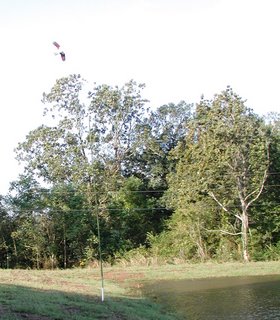
 Looks pretty good, doesnt it? I must say, though, the other day I came home from work and found the dog laying by the pond, and a big white crane standing in the pond, probably full of little fish - and the bird flying above. Oh, well. Usually that particular dog (Sweetie) barks at ANYTHING that flies, be it a bird or an airplane or whatever. But she wasn't doint it this day. To close, let me say that we have gotten a LOT of rain the past few weeks, and the pond is not completely full, but is getting there. Here it is, replenished:
Looks pretty good, doesnt it? I must say, though, the other day I came home from work and found the dog laying by the pond, and a big white crane standing in the pond, probably full of little fish - and the bird flying above. Oh, well. Usually that particular dog (Sweetie) barks at ANYTHING that flies, be it a bird or an airplane or whatever. But she wasn't doint it this day. To close, let me say that we have gotten a LOT of rain the past few weeks, and the pond is not completely full, but is getting there. Here it is, replenished: 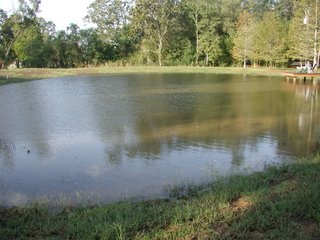
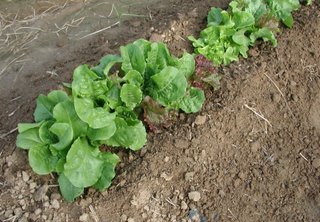
 we will have little yellow potatoes soon, and other wonderful fall-type produce. We have flowers again, which is so nice. August kills them all, and it is sad to have no flowers to cut. We have accidental zinnias, from the row I pulled up
we will have little yellow potatoes soon, and other wonderful fall-type produce. We have flowers again, which is so nice. August kills them all, and it is sad to have no flowers to cut. We have accidental zinnias, from the row I pulled up  (these were not planted, believe it or not). I did plant one other fence-row of them, but they're not nearly as nice. And, in a moment of loneliness, when Will was out of town, I got down and planted a row of French Marigolds. Will later fertilized them and did all of the mulching (thanks) and now they are the bright spot in the garden.
(these were not planted, believe it or not). I did plant one other fence-row of them, but they're not nearly as nice. And, in a moment of loneliness, when Will was out of town, I got down and planted a row of French Marigolds. Will later fertilized them and did all of the mulching (thanks) and now they are the bright spot in the garden.  I like this last picture: One of Will's sisters gave us a bunch of little metal signs for the garden. I like this one best, and move it around to the area that is most inspirational at the moment. Bad lighting, but it says 'INDULGE' ...More later; about Will's big paper/plastic owl kite. But I must take pictures first...
I like this last picture: One of Will's sisters gave us a bunch of little metal signs for the garden. I like this one best, and move it around to the area that is most inspirational at the moment. Bad lighting, but it says 'INDULGE' ...More later; about Will's big paper/plastic owl kite. But I must take pictures first... 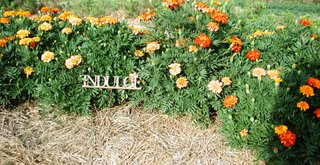
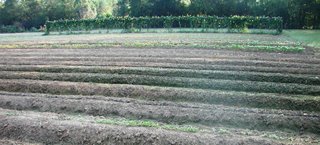
 Then we have 'some kind of beans'. You know they are beans from the wide flat big leaves. Just so happens these are green beans, but the red beans look much the same.
Then we have 'some kind of beans'. You know they are beans from the wide flat big leaves. Just so happens these are green beans, but the red beans look much the same.  Next, we have spinach...yum...
Next, we have spinach...yum... looks a lot like little blades of grass. Potatoes take a while to come up, but when the do, they have fat little strong stems and relatively small but thick leaves.
looks a lot like little blades of grass. Potatoes take a while to come up, but when the do, they have fat little strong stems and relatively small but thick leaves. Peas are very delicate, with rounded leaves..and are a lighter color of green.
Peas are very delicate, with rounded leaves..and are a lighter color of green.  Everything that is not in rows is a vast expanse of cover crop. Clay peas. Any kind of pea or bean can be used as a cover crop...you let them get as big as you like, or until you need the space for something else, then you plow them under. Nitrogen for the soil. There is more, but the sun came over the treeline, so that's all for this morning.
Everything that is not in rows is a vast expanse of cover crop. Clay peas. Any kind of pea or bean can be used as a cover crop...you let them get as big as you like, or until you need the space for something else, then you plow them under. Nitrogen for the soil. There is more, but the sun came over the treeline, so that's all for this morning. 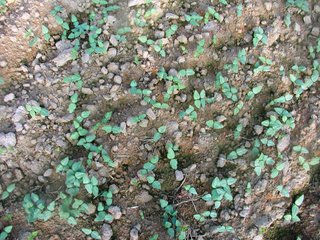 In the meantime, among all the newness of the Fall garden, we have this; an okra pod. Cut down and plowed under, something always survives. There are enough seeds in this old pod, laying at the edge of the field, to plant a whole row of okra. Life goes on.
In the meantime, among all the newness of the Fall garden, we have this; an okra pod. Cut down and plowed under, something always survives. There are enough seeds in this old pod, laying at the edge of the field, to plant a whole row of okra. Life goes on.

We are entering the sixth season of our CSA (Community Support Agriculture). What began as an experiment for the creative marketing of our produce has developed into a fulfilling experience for us and our members, one that we so look forward to each year. What you will find below is an explanation of how we operate the CSA, the cost, length of season, expected commitment, etc. We ask that you read it carefully before responding. We have dedicated members that stay on year after year, but for a number of folks, it is challenging to come out every Saturday for nine weeks running and to have time to participate. For those who love the quality of the vegetables, herbs, and flowers – and who like the experience of planting, harvesting, and interacting with others who have the same likes, it is a very rewarding experience. Please read on…
What is Community Supported Agriculture? (CSA)
Community supported agriculture is a movement that got its start in this country in the mid-1980’s, driven by a desire by neighborhood groups to re-connect with local growers and producers. The CSA movement is enjoying increasing popularity and availability with each passing year. The goal of CSA is to involve the vegetable-eating-public more intimately with “their” farm. Why do I use “their” in that description? Because in CSA, members buy a share of the farm which, in effect, provides them an ownership stake in the vegetables produced. In that respect, the farmer and consumer become partners. There are many benefits from this relationship to the farmer and consumer alike. For the farmer, it provides a guarantee of sales so he can plant to supply his contract. It also minimizes the time required to market the produce, freeing him up for what he does best, which is…farm. For the consumer, it guarantees a steady supply of farm fresh produce for a fixed price, encouraging healthy eating, and promoting a sense of participation and community around the farm that has been long lost in the age of industrial agriculture. For both the farmer and consumer, it promotes a bond based on trust and mutual interest. For those interested in information on CSA and farms that have set up these systems, the web has worlds of information available with a simple word search.
Why did Port Hudson Organics decided to become Port Hudson CSA?
For most of you who have spent any time visiting our farm and talking with us, you are aware that Thais and I both work full time, maintaining our little farm, bee hives, yard, and other farm-related activities in our “spare” time. This means that virtually every waking hour that we are not at work you would find us in the field or manning the produce tent (or carport). As we expanded our farm-related enterprises to areas such as biodiesel, berries and bee hives, the farm demands finally exceeded our available time. So in 2009, in order to continue our farm sustainability effort and reduce our time commitment (primarily the time spent selling), we tried a concept that is becoming increasingly popular across the country in the “Eat fresh, Eat local” movement, that is, the CSA farm. In the spring of 2009, we enrolled (what ended up to be) 25 CSA member families, and were blown-away by the success of the venture. Member enthusiasm, assistance, and clear appreciation for the unsurpassed quality of our produce resulted in an excellent experience for everyone involved. Since then, we have expanded our enrollment to approximately 40 member families, which is a comfortable carrying capacity of our one acre garden. At this point in our lives, with regular jobs and other commitments, we have no plans to expand further.
What kind of vegetables are grown and how are they distributed?
We grow a wide variety of Spring and Summer vegetables (generally about 20 different varieties). At any time during the season, you can expect around 12-15 different offerings, and 6-8 culinary herbs. We also grow cut flowers, usually zinnias and sunflowers. Each week members will receive a selection list by email. Members then make 7 selections of vegetables and 2 selections of herbs from the list. Members can check off their first and second preferences and we will make every effort to supply the members with their selected items. In cases where we are short on a particular item, say, yellow squash, we will substitute another available vegetable (for example, zucchini) from member’s second choice selection if at all possible. Members are free to make notes on their list if there is a particular vegetable they do not want (for example, zucchini) and we will try to honor their request. The amounts (pounds or numbers) of vegetables or herbs per selection were based on an approximation of equal value based on the prices we have charged for these items in the past. And as last year’s members know, the amounts of produce on the list are the minimum amount you will receive. Often, when there is a surplus beyond what has been selected, we will throw in some “lagniappe”. Members should note that there are a couple of exceptions on the selection list: a bouquet of flowers, when available, counts as two selections from the herb list; similarly, watermelon, when available, counts as two selections from the vegetable list. Each week, a basket with all of your produce and herbs will be made up with your list attached. Blank lists will be available for you to fill out for the following week, as the mix of produce and herbs change with the weather.
Can I select more than one of a particular item?
Yes, if you want 6 pounds of tomatoes one week, you can simply put the number “3” next to the selection “2 lbs. tomatoes” on your sheet and pick four other vegetable selections to make a total of seven selections. If we have enough tomatoes to satisfy your request, we will provide that amount. If we are short, we will attempt to at least provide you with one selection of tomatoes and make up the rest of your basket with other choices. We will let members know each week which vegetables we expect to have in abundance. For example, due to space considerations, we have limited plantings of corn and each planting is generally available for only one Saturday, so we will be encouraging members to select as much corn as they can from the list on the weeks that corn becomes available (we try to send out weekly emails on the state of the farm). Of course, members will also be given preference for the purchase of additional vegetables if, for example, you want to freeze a bushel of corn when it comes in and there is surplus available.
How will the CSA Baskets be distributed?
Members choose to come to the farm either Friday evening or Saturday morning each week during the season. Once you arrive, you can choose from a variety of garden activities in progress and lend a hand. This can range from planting and/or picking vegetables; washing, weighing, and bundling produce; cutting and arranging flowers; cutting and separating herbs to order; helping to pack baskets with weekly selections; sitting under a tree with other members and stripping beans off of plants. Occasionally there is a bigger project at hand, such as erecting the cucumber fence or helping to mulch rows with hay. There will be weeks when you are not able to help due to your schedule, but we find that most of our members help out almost every week. The process takes about an hour, and when you leave you bring your weekly basket with you. Many find this outdoor activity in the garden a respite from their work week in an office!
Members are asked to pick up their CSA baskets each Saturday by 10:00 AM. This is probably the biggest commitment you will make as part of the CSA. We understand that it may be difficult to come every Saturday for 9 weeks, but there are a couple of strategies you can employ to make this easier. (1) you can buddy-up with one or more members in your area and go on alternate Saturdays, each delivering or holding the other’s basket for pick up at their house; (2) you can send a family member or close friend; or (3) you can come Friday afternoon to help with the harvest and bring your basket home with you then (we had a lot of members take this option, as we do a lot of harvesting on Friday in advance of the Saturday bedlam).
What if you have a crop failure or natural disaster?
A CSA is a partnership between the farmer and the consumer, and within this partnership is an understanding of shared risk. That said, we do not expect members to bear the full cost of a catastrophic failure, nor have we ever experienced a completely failed season. Should the worst happen, members will be reimbursed a portion of their investment and we will do all in our power to make it right with members through a combination of refunds and discounts on following seasons.
What time commitment is asked as part of the CSA?
CSAs, by definition, include member support. Each week, literally hundreds of pounds of produce must be harvested, hundreds of bunches of herbs must be clipped and tied, and dozens of flower bouquets must be picked. Without member support, this is logistically impossible for part time farmers. Hence, we ask members to commit to help in some fashion (picking, sorting, filling orders, etc) according to their abilities every other weekend or so (we are not rigid on this). We have found that members enjoy becoming involved in the process. Learning about how food is grown and harvested is an uplifting and educational experience. After all, that is why we do it. And it is an integral part of CSA farms across the country. We are assuming that you found us because you appreciate this connection, and we hope that you can find the small amount of time to required to experience that connection.
What is the cost?
Cost of the CSA membership is $350. This covers 9 weeks of farm fresh vegetables, herbs, and flowers of your choice. This comes out to about $38 per week, probably more than you would pay at the grocery store for conventionally-grown produce, but less than you would pay for organic produce at Whole Foods. The quality of the produce, however, cannot be approached by any supermarket, and the experience is priceless. Also, membership in the CSA includes a pint of our farm honey when it becomes available.
In Summary
So that about covers it. If you want to experience first hand the pleasures of seeing, smelling, picking and eating truly wholesome food, please respond quickly to this email. We would appreciate some information on you and your family, and why you want to join the CSA. We will let you know within a few days, and will ask for payment at that time. We ask that you understand that we have about twice as many families on the waiting list as we have openings. However, if you do not make in into the CSA this year, we will give you first shot at joining next year if you are still interested.
Thank you so much for your interest in our little farm. We hope to see you this spring.
Will & Thais Perkins
Port Hudson Organics CSA




























































